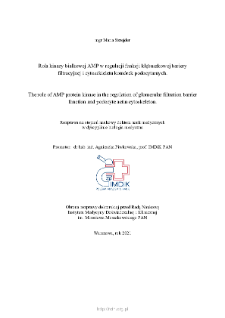- Search in all Repository
- Literature and maps
- Archeology
- Mills database
- Natural sciences
Advanced search
Advanced search
Advanced search
Advanced search
Advanced search

Object
Title: The role of AMP protein kinase in the regulation of glomerular filtration barier function and podocyte actin cytoskeleton
Contributor:
Piwkowska, Agnieszka (Promotor)
Place of publishing:
Degree name:
Level of degree:
Degree discipline :
Degree grantor:
Instytut Medycyny Doświadczalnej i Klinicznej im. M. Mossakowskiego PAN
Abstract:
Podocytes constitute a key element of glomerular filtration barrier mainly through a well-developed contractile apparatus formed by actin and myosin filament bundles. The podocyte foot processes along with the slit diaphragm proteins modulate the actin cytoskeleton dynamics and subsequent glomerular filtration. AMP-activated protein kinase (AMPK) is an essential enzyme responsible for maintaining energy homeostasis and proper metabolic response depending on changing environmental conditions, including stress conditions. Podocytes covering the external surface of the glomerular capillary seem to be a sensitive to a high glucose concentration or mechanical stress during glomerulopathies, including diabetic nephropathy. In pathological conditions release of nucleotides into extracellular space from glomeruli and podocytes is increased. Extracellular nucleotides act as signaling molecules through the P2 nucleotide receptors regulating vasoconstriction, thus contributing to the regulation of the glomerular filtration rate. The main goal of the study was investigation of the role of AMPK in hyperglycemia and P2 receptors in regulation of podocytes actin cytokeleton and permeability of glomerular filtration barrier. The experiments were performed using such experimental models as isolated rat glomeruli and primary culture of rat podocytes. This work demonstrated a decrease of AMPK phosphorylation level in podocytes with high level of glucose and increase of phosphorylation level after AMPK stimulation by metformin. Moreover, we observed that the changes mentioned above are correlated with the amount of TPRC6, which was increased in hyperglycemic conditions and then was restored to control values after AMPK activation. We showed a similar dependence in immunofluorescence staining and the degree of colocalization between AMPK and TRPC6, which was decreased in high glucose concentration and increased by AMPK stimulation. In this study we demonstrated a reduction of the amount of nephrin and changes in intracellular actin distribution in podocytes exposed to high glucose concentrations. Metformin treatment caused restoration of high glucose-induced changes in amount and intracellular location of proteins modulating actin cytoskeleton. Moreover, metformin through AMPK activation caused a reduction of permeability to albumin in podocytes under hyperglycemic conditions and diminution of glomerular permeability in diabetic rats. We showed that nucleotide stimulation in podocytes has an effect on restoration of energy homeostasis through AMPK activation and maintaining the oxidative balance through decreased ROS generation. Purinergic activation regulates the amount of synthesis of cyclic nucleotides (cGMP and cAMP) controlling the contractility of blood vessels. Furthermore, P2 activation, notably P2Y4, leads to a reorganization of actin cytoskeleton with accompanying an increase of permeability to albumin across podocyte monolayer. The process seems to be coupled with protein kinase A, whose suppression of activity prevented nucleotides-induced changes. In conclusion, the results of the present study offer evidence supporting a role for AMPK and purinergic signaling in regulating glomerular filtration through podocyte cytoskeleton remodeling. We believe that the proposed studies may become helpful in recognizing and understanding new defense mechanisms on the podocytes functioning, glomerular protection and preservation of normal renal function.
Detailed Resource Type:
Resource Identifier:
Source:
IMDiK PAN, sygn. ZS405 ; click here to follow the link
Language:
Language of abstract:
Rights:
Creative Commons Attribution BY 4.0 license
Terms of use:
Copyright-protected material. [CC BY 4.0] May be used within the scope specified in Creative Commons Attribution BY 4.0 license, full text available at: ; -
Digitizing institution:
Mossakowski Medical Research Institute PAS
Original in:
Library of the Mossakowski Medical Research Institute PAS
Projects co-financed by:
Access:
Object collections:
- Digital Repository of Scientific Institutes > Partners' collections > Mossakowski Medical Research Institute PAS
- Digital Repository of Scientific Institutes > Partners' collections > Mossakowski Medical Research Institute PAS > Theses > Ph.D Dissertationes
- Digital Repository of Scientific Institutes > Literature > Thesis
Last modified:
Jan 5, 2023
In our library since:
Jun 28, 2021
Number of object content downloads / hits:
95
All available object's versions:
https://rcin.org.pl./publication/229749

 INSTYTUT ARCHEOLOGII I ETNOLOGII POLSKIEJ AKADEMII NAUK
INSTYTUT ARCHEOLOGII I ETNOLOGII POLSKIEJ AKADEMII NAUK
 INSTYTUT BADAŃ LITERACKICH POLSKIEJ AKADEMII NAUK
INSTYTUT BADAŃ LITERACKICH POLSKIEJ AKADEMII NAUK
 INSTYTUT BADAWCZY LEŚNICTWA
INSTYTUT BADAWCZY LEŚNICTWA
 INSTYTUT BIOLOGII DOŚWIADCZALNEJ IM. MARCELEGO NENCKIEGO POLSKIEJ AKADEMII NAUK
INSTYTUT BIOLOGII DOŚWIADCZALNEJ IM. MARCELEGO NENCKIEGO POLSKIEJ AKADEMII NAUK
 INSTYTUT BIOLOGII SSAKÓW POLSKIEJ AKADEMII NAUK
INSTYTUT BIOLOGII SSAKÓW POLSKIEJ AKADEMII NAUK
 INSTYTUT CHEMII FIZYCZNEJ PAN
INSTYTUT CHEMII FIZYCZNEJ PAN
 INSTYTUT CHEMII ORGANICZNEJ PAN
INSTYTUT CHEMII ORGANICZNEJ PAN
 INSTYTUT FILOZOFII I SOCJOLOGII PAN
INSTYTUT FILOZOFII I SOCJOLOGII PAN
 INSTYTUT GEOGRAFII I PRZESTRZENNEGO ZAGOSPODAROWANIA PAN
INSTYTUT GEOGRAFII I PRZESTRZENNEGO ZAGOSPODAROWANIA PAN
 INSTYTUT HISTORII im. TADEUSZA MANTEUFFLA POLSKIEJ AKADEMII NAUK
INSTYTUT HISTORII im. TADEUSZA MANTEUFFLA POLSKIEJ AKADEMII NAUK
 INSTYTUT JĘZYKA POLSKIEGO POLSKIEJ AKADEMII NAUK
INSTYTUT JĘZYKA POLSKIEGO POLSKIEJ AKADEMII NAUK
 INSTYTUT MATEMATYCZNY PAN
INSTYTUT MATEMATYCZNY PAN
 INSTYTUT MEDYCYNY DOŚWIADCZALNEJ I KLINICZNEJ IM.MIROSŁAWA MOSSAKOWSKIEGO POLSKIEJ AKADEMII NAUK
INSTYTUT MEDYCYNY DOŚWIADCZALNEJ I KLINICZNEJ IM.MIROSŁAWA MOSSAKOWSKIEGO POLSKIEJ AKADEMII NAUK
 INSTYTUT PODSTAWOWYCH PROBLEMÓW TECHNIKI PAN
INSTYTUT PODSTAWOWYCH PROBLEMÓW TECHNIKI PAN
 INSTYTUT SLAWISTYKI PAN
INSTYTUT SLAWISTYKI PAN
 SIEĆ BADAWCZA ŁUKASIEWICZ - INSTYTUT TECHNOLOGII MATERIAŁÓW ELEKTRONICZNYCH
SIEĆ BADAWCZA ŁUKASIEWICZ - INSTYTUT TECHNOLOGII MATERIAŁÓW ELEKTRONICZNYCH
 MUZEUM I INSTYTUT ZOOLOGII POLSKIEJ AKADEMII NAUK
MUZEUM I INSTYTUT ZOOLOGII POLSKIEJ AKADEMII NAUK
 INSTYTUT BADAŃ SYSTEMOWYCH PAN
INSTYTUT BADAŃ SYSTEMOWYCH PAN
 INSTYTUT BOTANIKI IM. WŁADYSŁAWA SZAFERA POLSKIEJ AKADEMII NAUK
INSTYTUT BOTANIKI IM. WŁADYSŁAWA SZAFERA POLSKIEJ AKADEMII NAUK




































